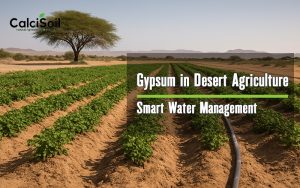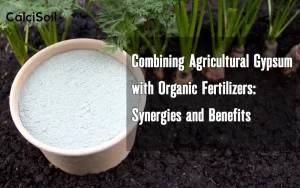
Agricultural gypsum is an important source of calcium and sulfur for crops. Not only is it easy for plants to absorb, but it also helps improve soil quality. Here are five essential agricultural gypsum benefits.
Agricultural gypsum Benefits:
1. Provides calcium and sulfur for plant nutrition.
“Plants are becoming increasingly deficient in sulfur (S) and the soil is not supplying them with enough sulfur,” says Warren Dick, Soil Scientist and Professor at the School of Environment and Natural Resources (SENR). from Ohio State University (United States). “Gypsum is an excellent source of sulfur that is used to nourish plants and improve crop yields.” On the other hand, it is essential to have calcium (Ca) so that most nutrients can be absorbed by the roots of the crop. “If there isn’t enough calcium, the absorption mechanisms don’t work,” says Dick. “Calcium helps stimulate root growth.”
2. Regulates acid soils and serves to treat aluminum toxicity.
One of the great agricultural gypsum benefits is its ability to reduce aluminum toxicity, which frequently accompanies soil acidity, and especially that of subsoils. According to Dick, gypsum can improve some acid soils even more than lime, promoting deeper roots that are of great benefit to crops: “Gypsum applied to the surface leaches into the subsoil and increases root growth.”
3. Improves soil structure.
“Developing a soil structure conducive to root growth and air and water movement requires flocculation, or aggregate formation,” says Jerry Bigham, Professor Emeritus at SENR. “Clay dispersal and structure collapse at the soil-air interface are some of the main factors that lead to crust formation on the soil,” he adds. “Gypsum has been used for many years to improve aggregate formation and inhibit dispersion in sodic soils.”
Soluble calcium improves soil aggregate formation and porosity, helping to increase water infiltration. “It’s important to manage the amount of calcium in the soil,” he says. “I would say it is as important as handling NPK.” In soils that have unfavorable calcium-magnesium ratios, gypsum can improve the ratio, says Bigham. “Adding soluble calcium can overcome the scattering effects of magnesium and sodium ions, as well as promote flocculation and structure development in dispersed soils.”
4. Promotes water infiltration.
The other part of benefits of agricultural gypsum is that gypsum also increases the drainage capacity of the soil, preventing it from becoming waterlogged due to a combination of high sodium content, expanding clay, and excess water. According to Dick, “We apply gypsum to the soil to allow water to soak in and the crop to grow well,” he adds. Increasing the efficiency of crops to use water during a drought is of paramount importance, says Allen Torbert, Chief Investigator of the National Soil Dynamics Lab, a research division of the United States Department of Agriculture. (USDA/ARS) from Auburn, Alabama.
“The key to helping crops survive a drought is to capture as much water as possible when it rains. “A good soil structure allows all the possible benefits of soil-water relationships to occur, and gypsum helps generate and produce good properties in that structure.”
5. Helps reduce runoff and erosion.
Agriculture is considered one of the activities that most contribute to water quality, with phosphorus (P) runoff being the most important concern. Experts explain how gypsum helps keep phosphorus and other nutrients inside crop fields. “Gypsum should be considered within Best Management Practices to reduce soluble P losses,” says Torbert, based on studies on how gypsum interacts with phosphorus.
For his part, Darrell Norton, a retired soil scientist from the USDA/ARS National Soil Erosion Research Laboratory, who works at Purdue University, assures that “using gypsum to amend the soil is the most economical way to control disperse pollution caused by phosphorus runoff.”







